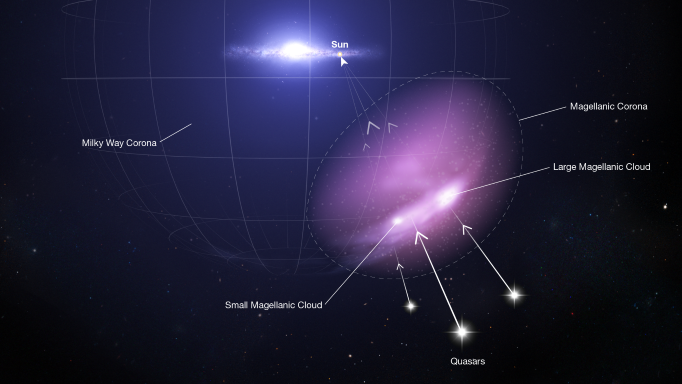Hubble detects protective shield defending Milky Way's closest galactic neighbours

The Large and Small Magellanic Clouds, two of the Milky Way's closest galactic neighbours - orbit one another as they are pulled in toward our home galaxy. Using data from NASA's Hubble Space Telescope and a retired satellite, astronomers have found that the Magellanic system is surrounded by a corona, a protective shield of hot supercharged gas.
The Magellanic Corona is thought to act as a buffer protecting the dwarf galaxies' vital star-forming gas from the gravitational pull of the much larger Milky Way. The protective shield stretches more than 100,000 light-years from the Magellanic clouds and covers a huge portion of the southern sky.
"Researchers think that a galaxy's corona is a remnant of the primordial cloud of gas that collapsed to form the galaxy billions of years ago. Although coronas have been seen around more distant dwarf galaxies, astronomers had never before been able to probe one in as much detail as this," NASA said in a statement.
The team, led by Dhanesh Krishnarao, assistant professor at Colorado College, detected and characterize the material surrounding the Large Magellanic Cloud by analysing patterns in ultraviolet light from 28 distant background quasars - the extremely bright cores of galaxies harbouring massive active black holes - confirming that the corona exists.
Galactic defense! 🛡️With the help of Hubble, astronomers have detected a protective “shield” that defends two dwarf galaxies that orbit our larger Milky Way Galaxy.This allows them to remain intact and form new stars. Learn more: https://t.co/xFlnPD6XQ6 pic.twitter.com/AnDg4ZxdmW
— Hubble (@NASAHubble) September 28, 2022
The study, published in the journal Nature, used archival observations of quasars from Hubble's Cosmic Origins Spectrograph (COS) and the Far Ultraviolet Spectroscopic Explorer (FUSE).
"The resolution of Hubble and FUSE were crucial for this study. The corona gas is so diffuse, it’s barely even there.” In addition, it is mixed with other gases, including the streams pulled from the Magellanic Clouds and material originating in the Milky Way," explained Krishnarao.
Wondering how can such a thin shroud of gas act as a defensive shield against other galaxies?
According to Krishnarao, anything that tries to pass into the galaxy has to pass through this material first, so it can absorb some of that impact.










